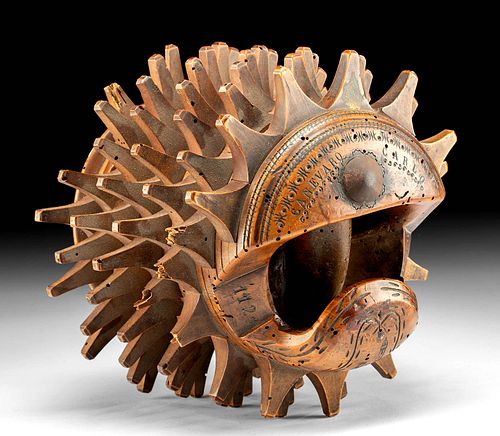Late 19th C. Italian Walnut Wood Bracciale Game Racket
Lot 130
About Seller
Artemis Gallery
686 S Taylor Ave, Ste 106
Louisville, CO 80027
United States
Selling antiquities, ancient and ethnographic art online since 1993, Artemis Gallery specializes in Classical Antiquities (Egyptian, Greek, Roman, Near Eastern), Asian, Pre-Columbian, African / Tribal / Oceanographic art. Our extensive inventory includes pottery, stone, metal, wood, glass and textil...Read more
Categories
Estimate:
$5,000 - $7,500
Absentee vs Live bid
Two ways to bid:
- Leave a max absentee bid and the platform will bid on your behalf up to your maximum bid during the live auction.
- Bid live during the auction and your bids will be submitted real-time to the auctioneer.
Bid Increments
| Price | Bid Increment |
|---|---|
| $0 | $25 |
| $300 | $50 |
| $1,000 | $100 |
| $2,000 | $250 |
| $5,000 | $500 |
| $10,000 | $1,000 |
| $20,000 | $2,500 |
| $50,000 | $5,000 |
| $100,000 | $10,000 |
| $200,000 | $20,000 |
About Auction
By Artemis Gallery
Dec 2, 2021
Set Reminder
2021-12-02 10:00:00
2021-12-02 10:00:00
America/New_York
Bidsquare
Bidsquare : Fine Antiquities | Asian | Ethnographic Art
https://www.bidsquare.com/auctions/artemis-gallery/fine-antiquities-asian-ethnographic-art-7918
Features classical antiquities, ancient and ethnographic art from cultures encompassing the globe. Egyptian, Greek, Roman, Etruscan, Near Eastern, Asian, Pre-Columbian, Native American, African / Tribal, Oceanic, Spanish Colonial, Russian, Fine / Visual Arts, so much more! Artemis Gallery info@artemisgallery.com
Features classical antiquities, ancient and ethnographic art from cultures encompassing the globe. Egyptian, Greek, Roman, Etruscan, Near Eastern, Asian, Pre-Columbian, Native American, African / Tribal, Oceanic, Spanish Colonial, Russian, Fine / Visual Arts, so much more! Artemis Gallery info@artemisgallery.com
- Lot Description
Central Europe, Italy, ca. 1876 CE. An unusual hand-carved walnut wood type of sporting equipment known as a bracciale, to use in the Italian ball game Pallone col bracciale translated to "ball with bracelet" and often known simply as "bracciale." This bracciale functioned as the "racket" for the game and is comprised of a cylindrical shape with a wide opening to wear on the forearm and at the other end of the tube is a vertical grip for the hand to hold and prevent the bracciale from slipping off. An upturned lip protects the knuckles and the face surrounding the grip opening is carved with the year "1876" and the names of players: "RUBINI GIUSEPPE" and "CANEVARO CARLO." The 7 rings of blunted spikes are individually carved then inserted into the cylinder surface; this is a hefty piece intended for someone with a slender arm. Improper hitting and serving of the leather balls with bracciale often resulted in broken arms simply due to the weight of these wooden cuffs! Size: 8" L x 8.5" Diameter (20.3 cm x 21.6 cm)
"Pallone" is the Italian word for inflated balls and the general name for games played with such balls; "pallone col bracciale" translates to "ball with bracelet" and is often known simply as "bracciale" which is what this spiked piece was use for. The inflated leather balls are hit back and forth with the wooden bracciale on the arm and points are scored like tennis. Bracciale originates sometime in the 16th century during the renaissance and revival of sports practiced by the ancient Greeks and Romans, but the game's height of popularity peaked in the 19th century in Italy and was adopted in several other European countries before losing popularity. Interest in the game diminished due to several factors including the rise of other sports, especially football, the cost of handmade wooden bracciali which made it inaccessible to most, and the difficulty playing the game correctly without serious arm injury!
This piece has been searched against the Art Loss Register database and has been cleared. The Art Loss Register maintains the world's largest database of stolen art, collectibles, and antiques.
Provenance: private Southern California collection, California, USA, acquired through descent 2006; ex-private California collection, USA, before 2000
All items legal to buy/sell under U.S. Statute covering cultural patrimony Code 2600, CHAPTER 14, and are guaranteed to be as described or your money back.
A Certificate of Authenticity will accompany all winning bids.
PLEASE NOTE: Due to recent increases of shipments being seized by Australian & German customs (even for items with pre-UNESCO provenance), we will no longer ship most antiquities and ancient Chinese art to Australia & Germany. For categories of items that are acceptable to ship to Australia or Germany, please contact us directly or work with your local customs brokerage firm.
Display stands not described as included/custom in the item description are for photography purposes only and will not be included with the item upon shipping.
#168549Old inactive insect damage and cavities throughout. Losses to tips of 4 spikes and complete losses to 2 spikes. Beautiful patina throughout. Engraved names and date are clear and discernable. Not recommended for use.Condition
- Shipping Info
-
All shipping is handled in-house for your convenience. Your invoice from Artemis Gallery will include shipping calculation instructions. If in doubt, please inquire BEFORE bidding for estimated shipping costs for individual items.
-
- Buyer's Premium



 EUR
EUR CAD
CAD AUD
AUD GBP
GBP MXN
MXN HKD
HKD CNY
CNY MYR
MYR SEK
SEK SGD
SGD CHF
CHF THB
THB















